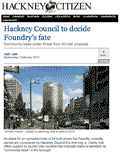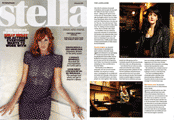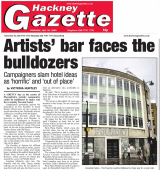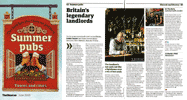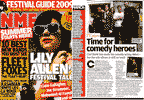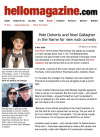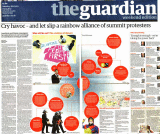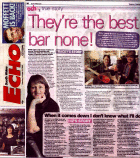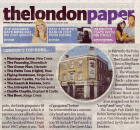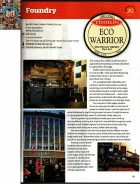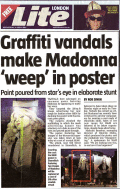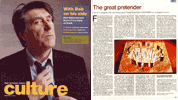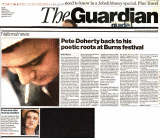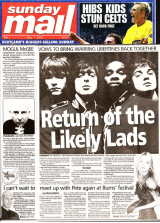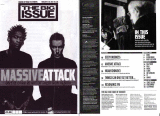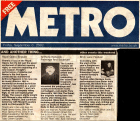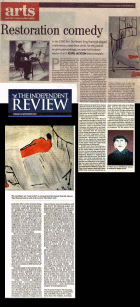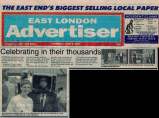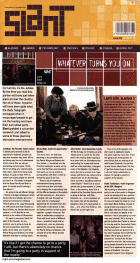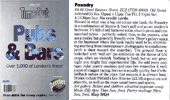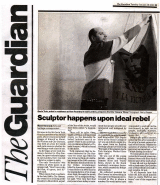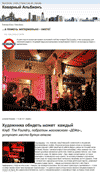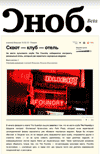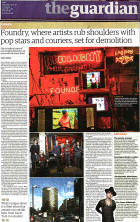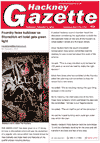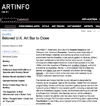[press - foundry]
[<<<] [>>>] click on image to enlarge
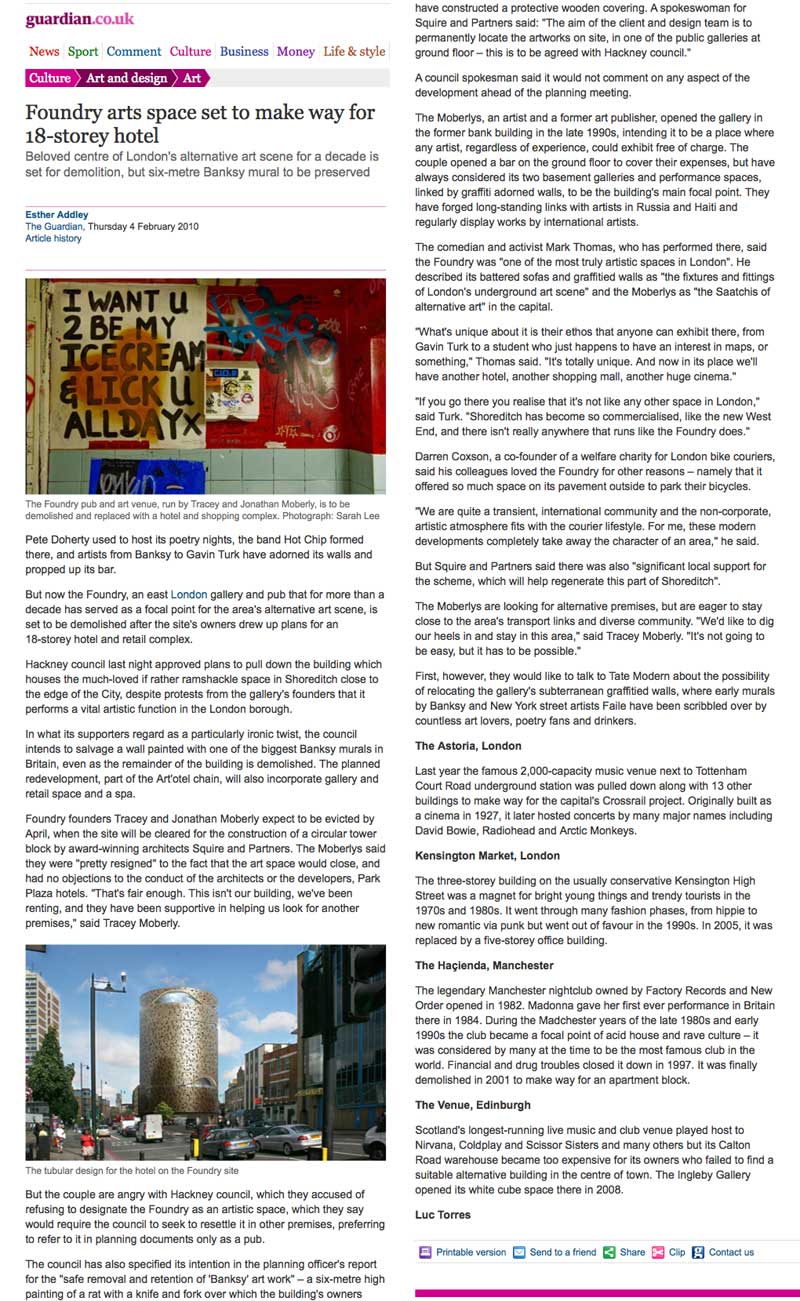
© tracey moberly 20100204.2.Foundry-arts-space-set-to-make-way-for-18-storey-hotel--Art-and-design--The-Guardian.jpg
The Guardian
[ link ]
The Foundry
Foundry arts space set to make way for 18-storey hotel
Beloved centre of London's alternative art scene for a decade is set for demolition, but six-metre Banksy mural to be preserved
Thursday 4 February 2010
Pete Doherty used to host its poetry nights, the band Hot Chip formed there, and artists from Banksy to Gavin Turk have adorned its walls and propped up its bar.
But now the Foundry, an east London gallery and pub that for more than a decade has served as a focal point for the area's alternative art scene, is set to be demolished after the site's owners drew up plans for an 18-storey hotel and retail complex.
Hackney council last night approved plans to pull down the building which houses the much-loved if rather ramshackle space in Shoreditch close to the edge of the City, despite protests from the gallery's founders that it performs a vital artistic function in the London borough.
In what its supporters regard as a particularly ironic twist, the council intends to salvage a wall painted with one of the biggest Banksy murals in Britain, even as the remainder of the building is demolished. The planned redevelopment, part of the Art'otel chain, will also incorporate gallery and retail space and a spa.
Foundry founders Tracey and Jonathan Moberly expect to be evicted by April, when the site will be cleared for the construction of a circular tower block by award-winning architects Squire and Partners. The Moberlys said they were "pretty resigned" to the fact that the art space would close, and had no objections to the conduct of the architects or the developers, Park Plaza hotels. "That's fair enough. This isn't our building, we've been renting, and they have been supportive in helping us look for another premises," said Tracey Moberly.
But the couple are angry with Hackney council, which they accused of refusing to designate the Foundry as an artistic space, which they say would require the council to seek to resettle it in other premises, preferring to refer to it in planning documents only as a pub.
The council has also specified its intention in the planning officer's report for the "safe removal and retention of 'Banksy' art work" – a six-metre high painting of a rat with a knife and fork over which the building's owners have constructed a protective wooden covering. A spokeswoman for Squire and Partners said: "The aim of the client and design team is to permanently locate the artworks on site, in one of the public galleries at ground floor – this is to be agreed with Hackney council."
A council spokesman said it would not comment on any aspect of the development ahead of the planning meeting.
The Moberlys, an artist and a former art publisher, opened the gallery in the former bank building in the late 1990s, intending it to be a place where any artist, regardless of experience, could exhibit free of charge. The couple opened a bar on the ground floor to cover their expenses, but have always considered its two basement galleries and performance spaces, linked by graffiti adorned walls, to be the building's main focal point. They have forged long-standing links with artists in Russia and Haiti and regularly display works by international artists.
The comedian and activist Mark Thomas, who has performed there, said the Foundry was "one of the most truly artistic spaces in London". He described its battered sofas and graffitied walls as "the fixtures and fittings of London's underground art scene" and the Moberlys as "the Saatchis of alternative art" in the capital.
"What's unique about it is their ethos that anyone can exhibit there, from Gavin Turk to a student who just happens to have an interest in maps, or something," Thomas said. "It's totally unique. And now in its place we'll have another hotel, another shopping mall, another huge cinema."
"If you go there you realise that it's not like any other space in London," said Turk. "Shoreditch has become so commercialised, like the new West End, and there isn't really anywhere that runs like the Foundry does."
Darren Coxson, a co-founder of a welfare charity for London bike couriers, said his colleagues loved the Foundry for other reasons – namely that it offered so much space on its pavement outside to park their bicycles.
"We are quite a transient, international community and the non-corporate, artistic atmosphere fits with the courier lifestyle. For me, these modern developments completely take away the character of an area," he said.
But Squire and Partners said there was also "significant local support for the scheme, which will help regenerate this part of Shoreditch".
The Moberlys are looking for alternative premises, but are eager to stay close to the area's transport links and diverse community. "We'd like to dig our heels in and stay in this area," said Tracey Moberly. "It's not going to be easy, but it has to be possible."
First, however, they would like to talk to Tate Modern about the possibility of relocating the gallery's subterranean graffitied walls, where early murals by Banksy and New York street artists Faile have been scribbled over by countless art lovers, poetry fans and drinkers.
The Astoria, London
Last year the famous 2,000-capacity music venue next to Tottenham Court Road underground station was pulled down along with 13 other buildings to make way for the capital's Crossrail project. Originally built as a cinema in 1927, it later hosted concerts by many major names including David Bowie, Radiohead and Arctic Monkeys.
Kensington Market, London
The three-storey building on the usually conservative Kensington High Street was a magnet for bright young things and trendy tourists in the 1970s and 1980s. It went through many fashion phases, from hippie to new romantic via punk but went out of favour in the 1990s. In 2005, it was replaced by a five-storey office building.
The Haçienda, Manchester
The legendary Manchester nightclub owned by Factory Records and New Order opened in 1982. Madonna gave her first ever performance in Britain there in 1984. During the Madchester years of the late 1980s and early 1990s the club became a focal point of acid house and rave culture – it was considered by many at the time to be the most famous club in the world. Financial and drug troubles closed it down in 1997. It was finally demolished in 2001 to make way for an apartment block.
The Venue, Edinburgh
Scotland's longest-running live music and club venue played host to Nirvana, Coldplay and Scissor Sisters and many others but its Calton Road warehouse became too expensive for its owners who failed to find a suitable alternative building in the centre of town. The Ingleby Gallery opened its white cube space there in 2008.
Comments in chronological order (Total 50 comments)
davidstraight
4 Feb 2010, 12:54AM
the death knell for shoreditch
Recommend? (15)
Alfonzo
4 Feb 2010, 2:54AM
That proposed building looks... well, it's beyond words. Just depressing.
It looks like we're going to have to say goodbye to the artists and hello to the art buyers - the people who claim to value culture as they mow it down, throwing bank notes as they go.
In a phrase? Kill yourself.
Recommend? (31)
Mediamogul
4 Feb 2010, 3:05AM
sigh
Recommend? (9)
littleroom
4 Feb 2010, 3:55AM
sigh
Recommend? (6)
BillytheSyd
4 Feb 2010, 4:43AM
It was over six years ago that I used to stand behind 'arty types' in Old Street post office as they transferred their PO boxes to Dalston before trudging off to Jaguar Shoes to rage against the dying of the light. You want to get yourself up to Clapton, that's where the real art scene is going to shit these days.
Probably.
Recommend? (9)
LeopoldButtersScotch
4 Feb 2010, 6:03AM
That proposed tubular design goes really well with the council flats on the right. I left London a few short years ago and I am really sad to hear that the Foundry will be torn down, and soon. This place was a truely iconic underground London venue/gallery/bar. What a big shame! Hopefully the Moberlys get some space in the area to do their thing again. I also hope after they've left, an absolute stonker of a squat party gets thrown in there. Do it properly and make all the former artists proud before the place gets knocked into Barney Rubble. Hackney Council are a bunch of . . . . . . . . twats!
Recommend? (13)
TheIdiotsAreWinning
4 Feb 2010, 6:30AM
Bummer. OK it's a shithole, and most of the art was appalling, but there was nowhere else like it and I had some great times there. Where will the worm lady recite her poetry now?
Fail
Recommend? (11)
tomsopinions
4 Feb 2010, 6:40AM
Oh well no biggy we can go and talk art and politics in starbucks - who needs character and diversity - hell pretty soon wholl need money - every little helps - take this as a warning!!!!!!!!!!!!!! get toghether make art !!!
Recommend? (4)
stumbuffer
4 Feb 2010, 7:25AM
I spit on your hotel
Recommend? (6)
discgolf
4 Feb 2010, 7:25AM
that proposed building looks... well, like it derives from a dark place
up from where burocrats normally put their broomsticks. Oops!
Recommend? (3)
ruse
4 Feb 2010, 7:27AM
bollox
Recommend? (3)
hinnerskov1
4 Feb 2010, 7:28AM
I used to drink there, work there and live there. Amazing to think there will now be a posh spa where we once had an electric shower cobbled together with gaffer tape and bin bags.
Recommend? (1)
BlahFlowers
4 Feb 2010, 7:40AM
Well Shoreditch was pretty rubbish anyway, but The Foundry was one of the few places worth venturing into the debris to visit, may the hotel replacing it be a massive commercial failure.
Recommend? (5)
Trouserpress
4 Feb 2010, 7:44AM
Fast forward to 2013 and the Guardian are talking up the 'Penge Renaissance' centred around a bracnh of Fast Frames, an ironically dangerous boozer and a minimart that sells Delice de France croissants.
Recommend? (5)
SaucyJack
4 Feb 2010, 8:08AM
This former Foundry staff member will always fondly remember a balmy summer night, sitting outside the Foundry on beer barrels, with the Moberlys and some Russians, drinking neat vodka and listening to Soviet work anthems on an antique gramaphone.
Recommend? (7)
edroolette
4 Feb 2010, 8:11AM
I spent the millennium eve party at the foundry. ten years later and its going. yet another depressing sign off the passing of better times...
Recommend? (1)
usualsuspect83
4 Feb 2010, 8:13AM
so they are saving the banksy? Dont they realise that just makes it worse? Not that I dont like banksy, but just because someones got famous doesnt mean its more worthy than the rest. The rest together is more than a million banksys, its a sense of community....
Recommend? (19)
sinjin
4 Feb 2010, 8:13AM
Here are a few good reasons for knocking the place down.
"Pete Doherty used to host its poetry nights, the band Hot Chip formed there, and artists from Banksy to Gavin Turk have adorned its walls and propped up its bar".
Great news! the Foundry is going. A kick in the teeth for art, yeah right.
Recommend? (8)
usualsuspect83
4 Feb 2010, 8:14AM
We used to go there every new years eve before going to wang.... sad day indeed!
Recommend? (0)
dcmtr
4 Feb 2010, 8:19AM
Hooray!
Recommend? (3)
antonyJ
4 Feb 2010, 8:27AM
Lo the inevitable.
Pete Doherty and some tat doesnt make something an 'art space'.
Hello Kingsland Road then...
Recommend? (1)
nabsy
4 Feb 2010, 8:36AM
art space?
it's a dingy bar where wannabe shoreditch types with expensive bikes and rich parents hang out.
some of the graffiti in the toilets made me smile though.
Recommend? (2)
discolo
4 Feb 2010, 8:47AM
I'm very sorry to hear this, I know the foundry well and I'm surprised it has lasted so long. Hackney council have never wanted the kind of "Culture" that places like the foundry,,, cultures. The whole anarchist/self sufficient thing does not fit in with the continuing gentrification of Hackney. No matter how much the council want to support it. Remember London Lane, the Samuel Pepys, the Hackney homeless festival, London fields Lido??? I could go on and on about how they've helped relocate and assist the alternative community, but you've heard it all before,and so have they.
I hope the Moberlys do dig their heels in, thats also a Hackney tradition in their community.
Recommend? (8)
IsRight
4 Feb 2010, 8:51AM
Good graffiti in the bogs and a nice wall of old battered tellys near the stairs.
Not been in here for a while but always enjoyed it when I did, used to have a Guiness before venturing onto fob close by on a Saturday night. Sorry to hear it is going.
Recommend? (0)
alexhogg
4 Feb 2010, 9:08AM
What a bunch of moaning minnies!!
Arts communities have always been transitary and always will be.
Lick your wounds for a few days then get your arses up to Clapton.
Recommend? (10)
letshavefacts
4 Feb 2010, 9:09AM
Looks to me like another piece of our querky British heritage has been mown down by international blandness and profit.
One day you won't be able to tell which country you are in.
Recommend? (2)
Girafa
4 Feb 2010, 9:14AM
It's not enough to say that art communities have always been transitory - the Foundry is/was a reliable oasis of ramshackleness in an overly sanitised world.
I always had the impression of spontaneity there, as though they'd just set the place up about an hour before I arrived.
Recommend? (5)
alexhogg
4 Feb 2010, 9:28AM
CLAPTON POND I tell you...CLAPTON POND!!!!
Recommend? (4)
alexhogg
4 Feb 2010, 9:31AM
GIRAFA: "I always had the impression of spontaneity there, as though they'd just set the place up about an hour before I arrived."
Maybe they saw you coming.
Recommend? (1)
Girafa
4 Feb 2010, 9:44AM
@Alexhogg - "Maybe they saw you coming"
heh heh I'd like to think so: Quick, Girafa's coming, he's at Old St roundabout already!
Recommend? (0)
sinjin
4 Feb 2010, 9:57AM
Yes the old good days of the Foundry. Like the time when a girls scarf went up in flames due to the height of the candles on there tables, and the way me and another bloke saved her from a certain fire ball death. I fondly remember this moment, and the moment when no-one form the Foundry took any notice or did anything, great days. Good ole Foundry, will be sorely missed for their disregard for substance.
Recommend? (0)
casinowilhelm
4 Feb 2010, 10:01AM
no point going to shoreditch any more - with the closure of the foundry it has completed its transition into the new upper street, ie basically any old shitty city centre drunken warzone.
Recommend? (3)
amhurstbrigade
4 Feb 2010, 10:08AM
I've spent many a fine night there being bitten by fleas listening to my mates Michael and Pete doing their set and although latterly the place became as much a tourist venue as the rest of the Hoxton/Shoreditch/OldStreet triangle it will be missed. However as an artist I was priced out of Shoreditch in 1993 not 2003 - we may well be on our way to Clapton Pond but that's only a stopping place - I predict all London artists will be relocated to Canvey Island and the bridges will be demolished - just before the sea level rises by 2m~~~
Recommend? (5)
hogarthterminal
4 Feb 2010, 10:15AM
underground a myth
Recommend? (0)
leonzos
4 Feb 2010, 10:16AM
My first exhibition in London was here. The foundry has a policy of no CV's, no artistic intervention or curation - just put your work up.
No doubt the corporate operated gallery in the basement of the hotel they are planning, will have some snooty middle class curator, with a masters in art history, and a penchant for the conceptual and overpriced. In other words like every other gallery down Vyner Street.
Well done hackney council for bowing to the money. Hope they paid you all well. The thing that galls most of all is that the whole Shoreditch/Hoxton area would be an undesirable area to live and stay in, were in not for the pioneering artists who made it trendy all those years ago - starting with the foundry.
Talk about gentrification.
The whole of Shoreditch is now a homogenised mess of semi trendy bars and hotels, pints starting at £4.50.
Recommend? (7)
JDS928
4 Feb 2010, 10:33AM
Sums up Shoreditch perfectly: its time has been and gone. Now there are more L-plate wearing hen parties here on weekends than in Leicester Square. Let the shiny buildings replace what is there so the idiots can keep paying £8 for a glass of blush wine and the rest can move on and start the next place. London is only great because it keeps having to reinvent itself.
Recommend? (4)
verte
4 Feb 2010, 10:34AM
I live in Clapton Pond and it's already getting expensive...
Shoreditch died a few years ago and the rot is slowly spreading to Dalston, which is now almost as unaffordable as Shoreditch, sadly.
Recommend? (2)
ollBOT
4 Feb 2010, 10:37AM
its a toilet tube, great!
Recommend? (0)
vertical
4 Feb 2010, 10:58AM
I would happily donate money towards the cremation of anything by the late Gavin Turk. Late because he played the Duchamp game 80 years on and still gets these kind of pathetic eulogies.
Is there a PayPal account I can send my money to?
nb. Warning to Hackney Council: Behind this new architectural facade is a tower of straw bales, which the developers will reveal in four years' time to everyones' bemusement. Do not give it planning permission.
Recommend? (1)
CoralieP
4 Feb 2010, 11:38AM
How depressing
Recommend? (0)
gaialive
4 Feb 2010, 12:32PM
Shoreditch? Sure-Bitch more like...
It's been dead for years, as anyone who was involved at the beginning already knows...
What's the big deal about The Foundry anyway? More 2nd hand business trading on the creative juices of the unknown, the forgotten, the untouchables and the unattainable. It's no small irony that it is to become a boutique hotel, since in a perverse reading of it's cultural history, that's all it ever was anyway.
So now all the media savvy cronies want to cry crocodile tears, over a social dynamic that they provoke, nourish and sustain?
Sure-Bitch!
Recommend? (0)
TimFoolery
4 Feb 2010, 1:40PM
I'm gutted like the rest of you, even though I had TWO pub bikes nicked from the railing outside there. The second one didn't even have a saddle!
However, some posters in this thread sound more than a little bitter. And confused. How can you extol the virtues of a space that fostered an open community yet berate all the johnny-come-latelys for not being there at the beginning, sharing one half of Strongbow, when most kids I saw in there before Christmas were eight years old in the late '90s? Why all this talk of the next hot coolspot (Clapton, your time has come - lucky you!) when it seems like nothing can ever be as good as it was in the past? It is not more important to piss on something first, than to love it for what it is, you know.
Recommend? (7)
AnotherFineDay
4 Feb 2010, 1:53PM
Anybody remember the Cooltan Arts centre in the old dole office in Brixton ? We were all kicked out years (and years ago), the building then left empty for ... years and years. What's there now ? A huge, empty space, growing nothing but weeds and buddleia.
Though maybe that's better than another, horrible, hotel.
It's always the same - money, money, money, money, money.
Recommend? (1)
Rexhamster
4 Feb 2010, 2:44PM
I went there once.
It was pretty rubbish
Get over yourselves
Recommend? (3)
Medalla
4 Feb 2010, 4:26PM
The Foundry performed an important part in the cultural life of London. Many artists exhibited their art works there. Several of those artists will be remembered long after The Foundry has gone.
The Foundry hosted several exhibitions of London Biennale artists, including the Eros Arrows show curated by Marisol Cavia and the 2nd Drawing Exhibition curated by Giacomo Picca assisted by Cecilia Madureira. Adam Nankervis, director of the nomadic MUSEUM MAN, performed there. So did Rino Telaro and many other international artists. Marko Stepanov made a drawing entitled 'Water Under the Bridge' in the gents' toilet. Salih Kayra of Cyprus showed his first film there.
Thank you, Tracy and Jonathan Moberley.
I wish you both great success in your next cultural project.
All the best from David Medalla, Director of the London Biennale
Recommend? (0)
Up2Here
4 Feb 2010, 6:39PM
I've had many many interesting nights at The Foundry.
There's really very little in the way of genuinely left-field venues left across London and any still standing seem to be on an invisible hit list if they are.
In turn they are normally replaced to make way for things London(ers) doesn't really need by companies (often from abroad as is the case here) who are after making a bit of fast cash helped by councils who are operating in much the same way, manned by councillors who are to put it kindly, don't really have the locals? interests as priority.
The alternatives we're presented with ideas like this are, as we've clearly seen, atmosphere free corporate sheds full of tasteless corporate concessions like the O2 erected as legacy fodder for suburban dwelling ministers who only go out once a year anyway.
Blankly put, would anyone really make a bee-line for a hotel in Old Street?
It's not the safest of places for a tourist to wander around with his wife and wide-eyed bunch of nippers. (we always have a bit of a laugh when we see the overnight stayers emerge from the Holiday Inn for a night on the town here in Croydon...I'd love to know where they end up!)
Also, The mere fact that it's being marketed as an "art'otel" IS acknowledging & patronising lip service to the fact that the area does actually need a place like The Foundry for people to display...If it ain't broke...
All that we see is going to replace it, is this bizarre eyesore which is not in any way good for locals or for that matter, the skyline.
It will also presumably be charging way over the local average for its services and operating on a much more exclusive basis than anything there already.
I'd also be very keen to see if the mentioned 'retail space' is going to be exclusive and independent, or just another replication of high street chains in bite size concession form.
To top this, Just as the Crossrail debacle in Central London has put countless people out of work and now defunct businesses were given almost no notice or compensation when they had to clear away.
The same will happen when the Old Street plans are inevitably extended to move on mini-cab firms & fast food outlets.
And I don't even want to begin reminding everyone of the mess and chaos that was brought to the traffic & pedestrian systems in the West End while their plans were in full swing.
Squire and Partners saying this is to help regenerate this part of Shoreditch is a pretty vague statement, I think we all really know how things like this work in London these days, and it's got very little to do with providing for the greater part of the London population.
Let me just thank The Moberleys for the great times I've had there.
There's never been any monkeys on the door searching down your pants before they let you enter, no Coke fuelled gangs in there out for a shanking spree and no crazed girlfights happening on every floor, I've always felt safe there and now will have one less reason to leave my South London cell for a simple bit of sociability & fun on a weekend in an ever growing erosion of a London that had a bit of character and individuality.
If I was Banksy, I'd pop down for the big last night party and knock the mural down as a protest myself. The whole thing sucks.
Recommend? (4)


